Chevrolet Spark 2020 Owner's Manual
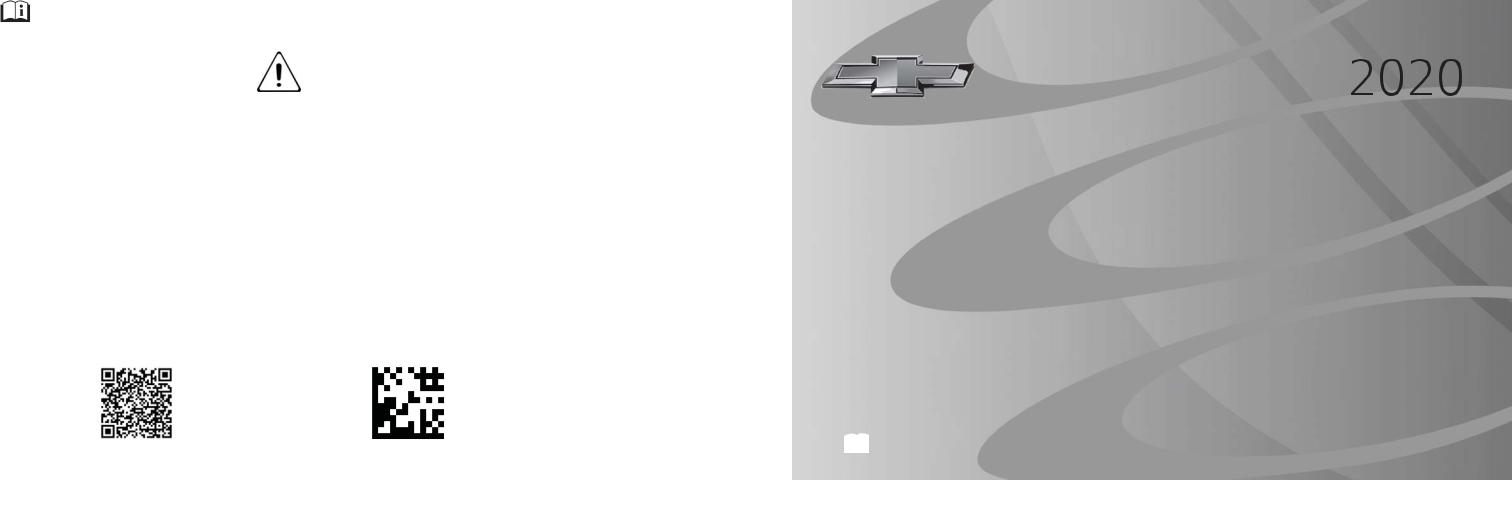
Spark
Owner’s Manual
chevrolet.com (U.S.) chevrolet.ca (Canada)

Contents
Introduction . . . . . . . . . . . . . . . . . . . . . . 2
Keys, Doors, and Windows . . . . . . 7
Seats and Restraints . . . . . . . . . . . 29
Storage . . . . . . . . . . . . . . . . . . . . . . . . . 76
Instruments and Controls . . . . . . . 79
Lighting . . . . . . . . . . . . . . . . . . . . . . . 109
Infotainment System . . . . . . . . . . . 116
Climate Controls . . . . . . . . . . . . . . 143
Driving and Operating . . . . . . . . . 148
Vehicle Care . . . . . . . . . . . . . . . . . . 196
Service and Maintenance . . . . . 273
Technical Data . . . . . . . . . . . . . . . . 287
Customer Information . . . . . . . . . 291
Reporting Safety Defects . . . . . . 301
OnStar . . . . . . . . . . . . . . . . . . . . . . . . 305
Connected Services . . . . . . . . . . . 313
Index . . . . . . . . . . . . . . . . . . . . 317

2Introduction
Introduction
The names, logos, emblems, slogans, vehicle model names, and vehicle body designs appearing in this manual including, but not limited to, GM, the GM logo, CHEVROLET, the CHEVROLET Emblem, and SPARK are trademarks and/or service marks of General Motors LLC, its subsidiaries, affiliates,
or licensors.
For vehicles first sold in Canada, substitute the name “General Motors of Canada Company” for Chevrolet Motor Division wherever it appears in this manual.
This manual describes features that may or may not be on the vehicle because of optional equipment that was not purchased on the vehicle, model variants, country specifications, features/applications that may not be available in your region, or changes subsequent to the printing of this owner’s manual.
Refer to the purchase documentation relating to your specific vehicle to confirm the features.
Keep this manual in the vehicle for quick reference.
Canadian Vehicle Owners
A French language manual can be obtained from your dealer, at www.helminc.com, or from:
Propriétaires Canadiens
On peut obtenir un exemplaire de ce guide en français auprès du concessionnaire ou à l'adresse suivante:
Helm, Incorporated
Attention: Customer Service
47911 Halyard Drive
Plymouth, MI 48170
USA
Using this Manual
To quickly locate information about the vehicle, use the Index in the back of the manual. It is an alphabetical list of what is in the manual and the page number where it can be found.
Litho in U.S.A. |
© 2019 General Motors LLC. All Rights Reserved. |
Part No. 84321087 A First Printing |

Introduction 3
Danger, Warning, and
Caution
Warning messages found on vehicle labels and in this manual describe hazards and what to do to avoid or reduce them.
{Danger
Danger indicates a hazard with a high level of risk which will result in serious injury or death.
{Warning
Warning indicates a hazard that could result in injury or death.
Caution
Caution indicates a hazard that could result in property or vehicle damage.
A circle with a slash through it is a safety symbol which means “Do Not,” “Do not do this,” or “Do not let this happen.”
Symbols
The vehicle has components and labels that use symbols instead of text. Symbols are shown along with the text describing the operation or information relating to a specific component, control, message, gauge, or indicator.
M : Shown when the owner’s manual has additional instructions or information.
* : Shown when the service manual has additional instructions or information.
0 : Shown when there is more information on another page — “see page.”
Vehicle Symbol Chart
Here are some additional symbols that may be found on the vehicle and what they mean. See the features in this manual for information.
u : Air Conditioning System
G : Air Conditioning Refrigerant Oil
9 : Airbag Readiness Light
! : Antilock Brake System (ABS) $ : Brake System Warning Light
9: Dispose of Used Components Properly
P: Do Not Apply High Pressure Water
B : Engine Coolant Temperature
_ : Flame/Fire Prohibited
H : Flammable
[: Forward Collision Alert
R: Fuse Block Cover Lock Location
+ : Fuses
j : ISOFIX/LATCH System Child Restraints

4Introduction
Q: Keep Fuse Block Covers
Properly Installed
|: Lane Change Alert
@ : Lane Departure Warning
A : Lane Keep Assist
* : Malfunction Indicator Lamp
: : Oil Pressure
X: Park Assist
~ : Pedestrian Ahead Indicator
O : Power
7: Rear Cross Traffic Alert
I : Registered Technician
/ : Remote Vehicle Start
> : Seat Belt Reminders
I : Side Blind Zone Alert
h : Stop/Start
7 : Tire Pressure Monitor
d : Traction Control/StabiliTrak/
Electronic Stability Control (ESC)
a : Under Pressure
V: Vehicle Ahead Indicator

Introduction 5
Instrument Panel Overview

6Introduction
1.Air Vents 0 145.
2.Exterior Lamp Controls 0 109.
Instrument Panel Illumination Control 0 113.
3.Turn and Lane-Change Signals 0 112.
Driver Information Center (DIC) Controls. See Driver Information Center (DIC) 0 98.
4.Instrument Cluster 0 84.
Driver Information Center (DIC) Display. See Driver Information Center (DIC) 0 98.
5.Windshield Wiper/Washer 0 80.
Rear Window Wiper/Washer 0 81.
6.Hazard Warning Flashers 0 112.
7.Light Sensor. See Automatic Headlamp System 0 111.
8.Infotainment. See Introduction
0 116.
9.Power Outlets 0 82.
10.Climate Control Systems 0 143.
11.Heated Front Seats 0 33 (If Equipped).
12.Shift Lever. See Automatic Transmission 0 171 (If Equipped) or Manual Transmission 0 173 (If Equipped).
13.Parking Brake 0 176.
14.Auxiliary Jack 0 127.
15.Ignition Positions (Keyless Access) 0 160 or
Ignition Positions (Key Access) 0 162.
16.Steering Wheel Controls 0 80
(If Equipped).
17.Horn 0 80.
18.Steering Wheel Adjustment
0 80 (Out of View).
19.Cruise Control 0 179 (If Equipped).
Forward Collision Alert (FCA) System 0 186 (If Equipped).
20.Traction Control/Electronic Stability Control 0 177.
Lane Departure Warning (LDW) 0 189 (If Equipped).
21.Instrument Panel Fuse Block 0 229.
22.Hood Release. See Hood
0 199.
23.Data Link Connector (DLC) (Out of View). See Malfunction Indicator Lamp (Check Engine Light) 0 89.

Keys, Doors, and Windows 7
Keys, Doors, and
Windows
Keys and Locks
Keys . . . . . . . . . . . . . . . . . . . . . . . . . . . . 7
Remote Keyless Entry (RKE)
System . . . . . . . . . . . . . . . . . . . . . . . 10
Remote Keyless Entry (RKE)
System Operation (Key
Access) . . . . . . . . . . . . . . . . . . . . . . 10
Remote Keyless Entry (RKE)
System Operation (Keyless
Access) . . . . . . . . . . . . . . . . . . . . . . 13
Door Locks . . . . . . . . . . . . . . . . . . . . 17
Power Door Locks . . . . . . . . . . . . . 17
Delayed Locking . . . . . . . . . . . . . . . 18
Automatic Door Locks . . . . . . . . . 18
Lockout Protection . . . . . . . . . . . . . 18
Safety Locks . . . . . . . . . . . . . . . . . . . 19
Doors
Liftgate . . . . . . . . . . . . . . . . . . . . . . . . 20
Vehicle Security
Vehicle Security . . . . . . . . . . . . . . . . 21
Vehicle Alarm System . . . . . . . . . 21
Immobilizer . . . . . . . . . . . . . . . . . . . . 22
Immobilizer Operation (Key
Access) . . . . . . . . . . . . . . . . . . . . . . 22
Immobilizer Operation (Keyless
Access) . . . . . . . . . . . . . . . . . . . . . . 23
Exterior Mirrors
Convex Mirrors . . . . . . . . . . . . . . . . 24
Manual Mirrors . . . . . . . . . . . . . . . . . 24
Power Mirrors . . . . . . . . . . . . . . . . . . 25
Folding Mirrors . . . . . . . . . . . . . . . . . 25
Heated Mirrors . . . . . . . . . . . . . . . . . 25
Interior Mirrors
Interior Rearview Mirrors . . . . . . . 25
Manual Rearview Mirror . . . . . . . . 25
Windows
Windows . . . . . . . . . . . . . . . . . . . . . . . 26
Manual Windows . . . . . . . . . . . . . . 26
Power Windows . . . . . . . . . . . . . . . 26
Sun Visors . . . . . . . . . . . . . . . . . . . . . 27
Roof
Sunroof . . . . . . . . . . . . . . . . . . . . . . . . 28
Keys and Locks
Keys
{Warning
Leaving children in a vehicle with the ignition key is dangerous and children or others could be seriously injured or killed. They could operate the power windows or other controls or make the vehicle move. The windows will function with the keys in the ignition, and children or others could be caught in the path of a closing window. Do not leave children in a vehicle with the ignition key.
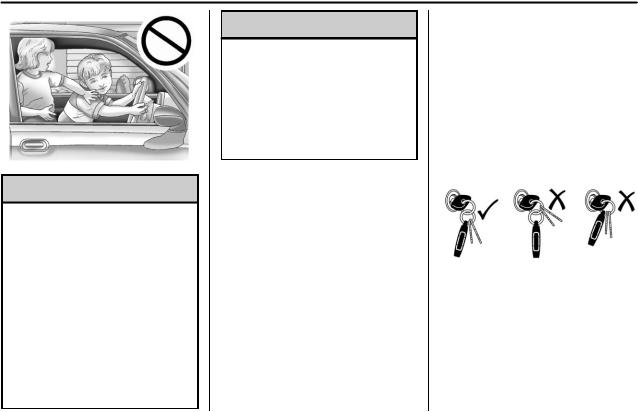
8Keys, Doors, and Windows
{Warning
If the key is unintentionally rotated while the vehicle is running, the ignition could be moved out of the RUN position. This could be caused by heavy items hanging from the key ring, or by large or long items attached to the key ring that could be contacted by the driver or steering wheel. If the ignition moves out of the RUN position, the engine will shut off, braking and steering power assist may be
(Continued)
Warning (Continued)
impacted, and airbags may not deploy. To reduce the risk of unintentional rotation of the ignition key, do not change the way the ignition key and Remote Keyless Entry (RKE) transmitter, if equipped, are connected to the provided key rings.
The ignition key and key rings, and RKE transmitter, if equipped, are designed to work together as a system to reduce the risk of unintentionally moving the key out of the RUN position. The ignition key has a small hole to allow attachment of the provided key ring. It is important that any replacement ignition keys have a small hole. See your dealer if a replacement key is required.
The combination and size of the rings that came with your keys were specifically selected for your vehicle. The rings are connected to the key like two links of a chain to
reduce the risk of unintentionally moving the key out of the RUN position. Do not add any additional items to the ring attached to the ignition key. Attach additional items only to the second ring, and limit added items to a few essential keys or small, light items no larger than an RKE transmitter.

Keys, Doors, and Windows 9
Interference from radio-frequency identification (RFID) tags may prevent the key from starting the vehicle. Keep RFID tags away from the key when starting the vehicle.
The key that is part of the Remote Keyless Entry (RKE) transmitter can be used for the ignition and all locks.
Press the button on the front of the RKE transmitter to extend the key. Never extend the key without pressing the button.
Press the button and the key blade to retract the key.
LS
2LT
The 2LT key can be used for all 1LT locks. This vehicle has pushbutton
start.

10 Keys, Doors, and Windows
Press the button on the side of the RKE transmitter to release the key. Never take the key out without pressing the button.
See your dealer if a new key is needed.
If it becomes difficult to turn the key, inspect the key blade for debris. Periodically clean with a brush
or pick.
If you are locked out of the vehicle, see Roadside Assistance Program 0 295.
With an active OnStar or connected service plan, an OnStar Advisor may remotely unlock the vehicle. See OnStar Overview 0 305.
Remote Keyless Entry
(RKE) System
See Radio Frequency Statement 0 301.
If there is a decrease in the Remote Keyless Entry (RKE) operating range:
.Check the distance. The transmitter may be too far from the vehicle.
.Check the location. Other vehicles or objects may be blocking the signal.
.Check the transmitter's battery. See “Battery Replacement” later in this section.
.If the transmitter is still not working correctly, see your dealer or a qualified technician for service.
Remote Keyless Entry
(RKE) System Operation
(Key Access)
The RKE transmitter may work up to 60 m (167 ft) away from the vehicle.
Other conditions can affect the performance of the transmitter. See
Remote Keyless Entry (RKE) System 0 10.
1LT
The following buttons are on the transmitter:
Q : Press once to lock all doors, the fuel door, and the liftgate. The turn signal indicators may flash and/or the horn may sound on the second press to indicate locking.
If the driver door is open when Q is pressed and Open Door Anti Lock Out is enabled through the vehicle personalization, all doors will lock and then the driver door will immediately unlock. If the

Keys, Doors, and Windows 11
passenger door is open when Q is pressed, all doors lock. See Vehicle Personalization 0 105.
Pressing Q may also arm the theft-deterrent system. See Vehicle Alarm System 0 21.
K : Press to unlock the driver door and the fuel door. Press again within five seconds to unlock all doors and the liftgate. The turn signal indicators flash to indicate unlocking has occurred.
See Vehicle Personalization 0 105.
Pressing K may also disarm the theft-deterrent system. See Vehicle Alarm System 0 21.
7 : Press and release one time to initiate vehicle locator. The exterior lamps flash and the horn chirps
three times. Press and hold 7 for at least three seconds to sound the panic alarm. The horn sounds and the turn signals flash for
30 seconds, or until 7 is pressed again, or the key is placed in the ignition and turned on.
Programming Keys to the Vehicle
Only keys programmed to this vehicle will work. If a key is lost or stolen, a replacement can be purchased and programmed through your dealer. When the replacement key is programmed to this vehicle, all remaining keys must also be reprogrammed. Any lost or stolen keys will no longer work once the new key is programmed.
Programming with Two
Recognized Keys
To program a new key:
1.Insert the original, already programmed key in the ignition and turn the ignition on without starting the vehicle.
2.Turn the ignition off, and remove the key.
3.Quickly, within five seconds, insert the second original already programmed key in the ignition and turn the ignition on without starting the vehicle.
4.Turn the ignition off, and remove the key.
5.Insert the new key to be programmed, and within
five seconds, turn the ignition on without starting the vehicle.
The security light will turn off once the key has been programmed.
6.Repeat Steps 1–5 if additional keys are to be programmed.
If a key is lost or damaged, see your dealer to have a new key made.
Programming without a
Recognized Key
Program a new key to the vehicle when a recognized key is not available. Canadian regulations require that owners see their dealer.
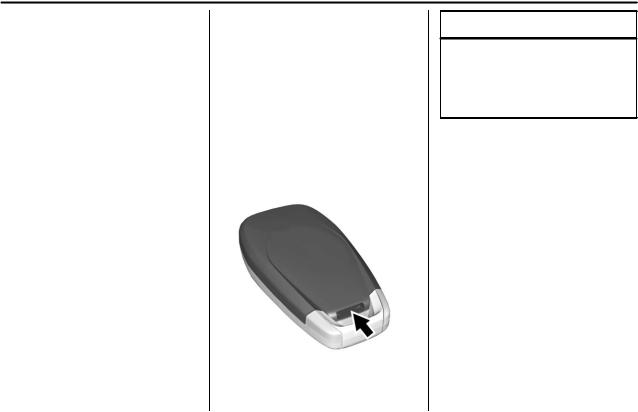
12 Keys, Doors, and Windows
If two currently recognized keys are not available, follow this procedure to program the first key.
This procedure will take approximately 30 minutes to complete for the first key. The vehicle must be off and all of the keys you wish to program must be with you.
1.Insert the new vehicle key into the ignition.
2.Turn the ignition on without starting the vehicle. The security light will come on.
3.Wait 10 minutes until the security light turns off.
4.Turn the ignition off.
5.Repeat Steps 2–4 two more times. After the third time, turn the ignition on without starting the vehicle; the key is learned and all previously known keys will no longer work with the vehicle.
6.To program the second key, turn the ignition off and insert the second key to be learned and turn the ignition on without starting the vehicle.
After the two keys are learned, remaining keys can be learned by following the procedure in “Programming with Two Recognized Keys.”
Battery Replacement
(1LT Only)
Caution
When replacing the battery, do not touch any of the circuitry on the transmitter. Static from your body could damage the transmitter.
The battery is not rechargeable. To replace the battery:
1.Press the button on the side of the RKE transmitter to extend the key. Never pull the key out without pressing the button.
2.Remove the battery cover by prying it with a finger.
3.Remove the battery by pushing on the battery and sliding it toward the key blade.
4.Insert the new battery, positive side facing up. Push the battery down until it is held in place. Replace with a CR2032 or equivalent battery.
5.Snap the battery cover back on to the transmitter.

Keys, Doors, and Windows 13
Remote Keyless Entry
(RKE) System Operation
(Keyless Access)
The Keyless Access system allows for vehicle entry when the Remote Keyless Entry (RKE) transmitter is within 1 m (3 ft). See “Keyless Access Operation” later in this section.
The RKE transmitter may work up to 60 m (167 ft) away from the vehicle.
Other conditions can affect the performance of the RKE transmitter. See Remote Keyless Entry (RKE) System 0 10.
2LT
The following buttons are on the transmitter:
Q : Press once to lock all doors, the fuel door, and the liftgate. The turn signal indicators may flash and/or the horn may sound on the second press to indicate locking.
If the driver door is open when Q is pressed and Open Door Anti Lock Out is enabled through the vehicle personalization, all doors will lock and then the driver door will immediately unlock. If the
passenger door is open when Q is pressed, all doors lock. See Vehicle Personalization 0 105.
Pressing Q may also arm the theft-deterrent system. See Vehicle Alarm System 0 21.
K : Press to unlock the driver door and the fuel door. Press again within five seconds to unlock all doors and the liftgate. The turn signal indicators flash to indicate unlocking has occurred.
See Vehicle Personalization 0 105.
Pressing K may also disarm the theft-deterrent system. See Vehicle Alarm System 0 21.
7 : Press and release one time to initiate vehicle locator. The exterior lamps flash and the horn chirps
three times. Press and hold 7 for at least three seconds to sound the panic alarm. The horn sounds and

14 Keys, Doors, and Windows
the turn signals flash for
30 seconds, or until 7 is pressed again or the ignition is turned on.
Keyless Access Operation
If equipped, the Keyless Access system lets you lock and unlock the doors and access the liftgate without removing the RKE transmitter from your pocket, purse, briefcase, etc. The RKE transmitter should be within 1 m (3 ft) of the liftgate or door being opened. If the vehicle has this feature, there will be buttons on the outside front door handles.
The vehicle can be customized to always unlock all doors on the first lock/unlock button press. See
Vehicle Personalization 0 105.
Keyless Unlocking/Locking from the Driver Door
When the doors are locked and the RKE transmitter is within 1 m (3 ft) of the driver door handle, pressing the lock/unlock button on the driver door handle will unlock the driver door. If the lock/unlock button is
pressed again within five seconds, all passenger doors will unlock. Pull the door handle to unlatch the door.
Driver Side Shown, Passenger
Similar
Pressing the lock/unlock button will cause all doors to lock if any of the following occur:
.It has been no more than
five seconds since the first lock/ unlock button press.
.Two lock/unlock button presses were used to unlock all doors.
.Any vehicle door has opened and all doors are now closed.
Keyless Unlocking/Locking from the Passenger Doors
When the doors are locked and the RKE transmitter is within 1 m (3 ft) of the passenger door handle, pressing the lock/unlock button on the passenger door handle will unlock all doors.
Pressing the lock/unlock button will cause all doors to lock if any of the following occur:
.The lock/unlock button was used to unlock all doors.
.Any vehicle door has opened and all doors are now closed.
Disable/Enable Keyless Unlocking
of Exterior Door Handles and
Liftgate
If equipped, keyless unlocking of the exterior door handles and liftgate can be disabled and enabled.
Disabling Keyless Unlocking:
With the vehicle off, press and hold Q and K on the RKE transmitter at the same time for approximately three seconds. The

Keys, Doors, and Windows 15
turn signal lamps will flash four times quickly to indicate access is disabled. Using any exterior handle to unlock the doors or open the liftgate will cause the turn signal lamps to flash four times quickly, indicating access is disabled.
If disabled, disarm the alarm system before starting the vehicle.
Enabling Keyless Unlocking:
With the vehicle off, press and hold Q and K on the RKE transmitter at the same time for approximately three seconds. The turn signal lamps will flash twice quickly to indicate access is enabled.
Passive Locking
If equipped with Keyless Access, the vehicle will lock several seconds after all doors are closed if the vehicle is off and at least one transmitter has been removed or none remain in the vehicle.
The fuel door will lock.
If other electronic devices interfere with the RKE transmitter signal, the vehicle may not detect the RKE transmitter inside the vehicle.
If passive locking is enabled, the doors may lock with the RKE transmitter inside the vehicle. Do not leave the RKE transmitter in an unattended vehicle.
Temporary Disable of Passive
Locking
Temporarily disable passive locking by pressing and holding K on the interior door switch with a door open for at least four seconds, or until three chimes are heard. Passive locking will then remain disabled until Q on the interior door is pressed, or until the vehicle is turned on.
To customize the doors to automatically lock when exiting the vehicle, see Vehicle Personalization 0 105.
Remote Left In Vehicle Alert
When the vehicle is turned off and an RKE transmitter is left in the vehicle, the horn will chirp three times after all doors are closed. To turn on or off see Vehicle Personalization 0 105.
Remote No Longer in Vehicle Alert
If the vehicle is on with a door open, and then all doors are closed, the vehicle will check for RKE transmitters inside. If an RKE transmitter is not detected, the Driver Information Center (DIC) will display NO REMOTE DETECTED and the horn will chirp three times. This occurs only once each time the vehicle is driven. To turn on or off see Vehicle Personalization 0 105.
Keyless Liftgate Opening
To open the liftgate, press the touch pad on the rear of the liftgate above the license plate. The doors must be unlocked or the RKE transmitter must be within 1 m (3 ft).
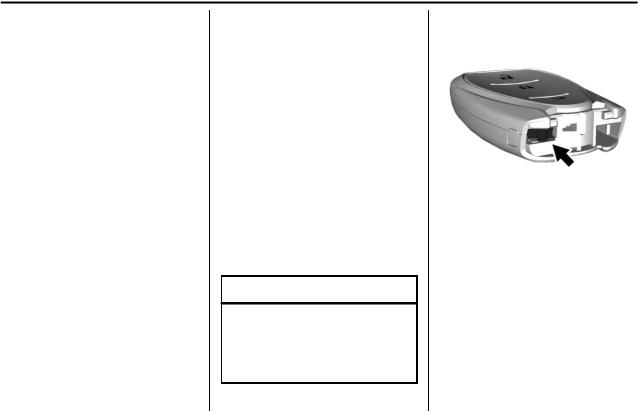
16 Keys, Doors, and Windows
Key Access
To access a vehicle with a weak transmitter battery, see Door Locks
0 17.
Programming Transmitters to the Vehicle
Only RKE transmitters programmed to the vehicle will work. If a transmitter is lost or stolen, a replacement can be purchased and programmed through your dealer. The vehicle can be reprogrammed so that lost or stolen transmitters no longer work. Any remaining transmitters will need to be reprogrammed. Each vehicle can have up to eight transmitters matched to it.
Starting the Vehicle with a Low Transmitter Battery
If the transmitter battery is weak, the DIC may display NO REMOTE DETECTED when trying to start the vehicle. The DIC may also display REPLACE BATTERY IN
REMOTE KEY.
To start the vehicle:
1.Place the transmitter in the transmitter pocket with the buttons facing the front of the vehicle.
2.With the vehicle in P (Park) or N (Neutral), press the brake pedal, and press ENGINE START/STOP.
Replace the transmitter battery as soon as possible.
Battery Replacement
(2LT Only)
Replace the battery in the transmitter soon if the DIC displays REPLACE BATTERY IN
REMOTE KEY.
Caution
When replacing the battery, do not touch any of the circuitry on the transmitter. Static from your body could damage the transmitter.
To replace the battery:
1.Remove the key from the RKE transmitter.
2.Insert a flat, thin object in the center of the transmitter to separate and remove the back cover.
3.Lift the battery with a flat object.
4.Remove the battery.
5.Insert the new battery, positive side toward the back cover. Replace with a CR2032 or equivalent battery.

Keys, Doors, and Windows 17
6.Push the transmitter together.
7.Reinsert the key.
Door Locks
{Warning
Unlocked doors can be dangerous.
.Passengers, especially children, can easily open the doors and fall out of a moving vehicle. The doors can be unlocked and opened while the vehicle is moving. The chance of being thrown out of the vehicle in a crash is increased if the doors are not locked. So, all passengers should wear seat belts properly and the doors should be locked whenever the vehicle is driven.
(Continued)
Warning (Continued)
.Young children who get into unlocked vehicles may be unable to get out. A child can be overcome by extreme heat and can suffer permanent injuries or even death from heat stroke. Always lock the vehicle whenever leaving it.
.Outsiders can easily enter through an unlocked door when you slow down or stop the vehicle. Locking the doors can help prevent this from happening.
To lock or unlock the doors from outside the vehicle, use the key in
the driver door or press Q or K on the RKE transmitter. See Remote Keyless Entry (RKE) System Operation (Key Access) 0 10 or Remote Keyless Entry (RKE) System Operation (Keyless Access) 0 13.
Keyless Access
If equipped, the RKE transmitter must be within 1 m (3 ft) of the door or liftgate being opened.
Press the button on the door handle to open. See “Keyless Access Operation” under Remote Keyless Entry (RKE) System Operation (Key Access) 0 10 or
Remote Keyless Entry (RKE) System Operation (Keyless Access) 0 13.
Power Door Locks

18 Keys, Doors, and Windows
To lock and unlock the doors from inside the vehicle:
.Press Q or K, if equipped.
.Use the lock knob on the top of the door panel.
Delayed Locking
This feature delays the locking of the doors until five seconds after all doors are closed.
Delayed locking can only be turned on when the Open Door Anti-Lockout feature has been turned off.
When Q is pressed on the power door lock switch while the door is open, a chime will sound three times indicating delayed locking is active.
The doors will lock automatically five seconds after all doors are closed. If a door is reopened before that time, the five-second timer will reset when all doors are closed again.
Press Q on the door lock switch
again or press Q on the RKE transmitter to lock the doors immediately.
This feature can also be programmed. See Vehicle Personalization 0 105.
Automatic Door Locks
If equipped, the vehicle is programmed so that when the doors are closed, the ignition is on, and the shift lever is moved out of
P (Park) for automatic transmissions, or the vehicle speed is above 13 km/h (8 mph) for manual transmissions, the doors and the liftgate will lock.
To unlock the doors and the liftgate:
.Press K on the door.
.If equipped with an automatic transmission, shift the transmission into P (Park).
.If equipped with a manual transmission, remove the key from the ignition.
Lockout Protection
Key Access : When locking is requested with the driver door open and the key in the ignition, all the doors will lock and then the driver door will unlock.
This can be manually overridden by pressing and holding Q on the power door lock switch.
Keyless Access : When locking is requested with the driver door open and the vehicle is on or in ACC/ ACCESSORY, all the doors will lock and then the driver door will unlock.
If the vehicle is off and locking is requested while a door is open, when all doors are closed the vehicle will check for RKE transmitters inside. If an RKE transmitter is detected and the number of RKE transmitters inside has not reduced, the driver door will unlock and the horn will sound three times.
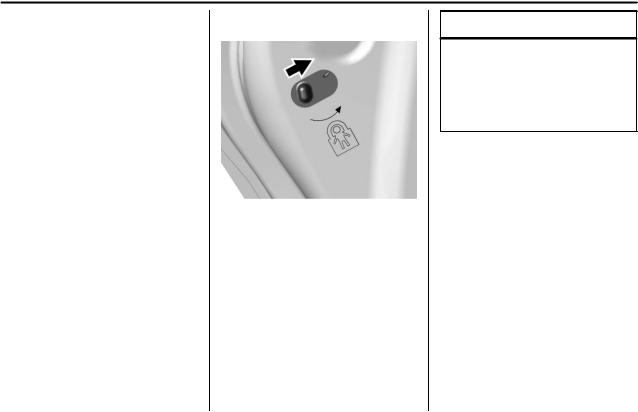
Keys, Doors, and Windows 19
This can be manually overridden by pressing and holding Q on the power door lock switch.
Open Door Anti-Lockout
If Open Door Anti-Lockout is turned on and the vehicle is off, the driver door is open, and locking is requested, all the doors will lock and the driver door will remain open. Press the button again to lock the driver door. The Open Door Anti-Lockout feature can be turned on or off. See Vehicle Personalization 0 105.
Safety Locks
The vehicle has rear door safety locks on each rear door that prevent passengers from opening the rear doors from the inside.
Using the Rear Door
Safety Lock
1.Move the lever up to lock.
2.Close the door.
3.Repeat Steps 1 and 2 for the other rear door lock.
Caution
Pulling the inside door handle while the rear door safety locks are engaged could damage your vehicle. Do not pull the inside door handle while the rear door safety locks are engaged.
The rear doors on the vehicle cannot be opened from the inside while this feature is in use.
Opening a Rear Door When the
Safety Lock Is On
1.Unlock the door from the inside.
2.Open the door from the outside.
For the rear doors to open from the inside, the safety locks have to be moved back to the unlock position.

20 Keys, Doors, and Windows
Canceling a Rear Door
Safety Lock
1.Unlock the door from the inside and open the door from the outside.
2.Move the lever down to unlock.
3.Repeat Steps 1 and 2 for the other rear door lock.
The rear door locks can now be locked and unlocked normally.
Doors
Liftgate
{Warning
Exhaust gases can enter the vehicle if it is driven with the liftgate, hatch/trunk open, or with any objects that pass through the seal between the body and the hatch/trunk or liftgate. Engine exhaust contains carbon monoxide (CO) which cannot be seen or smelled. It can cause unconsciousness and even death.
If the vehicle must be driven with the liftgate or hatch/trunk open:
.Close all of the windows.
.Fully open the air outlets on or under the instrument panel.
.Adjust the climate control system to a setting that brings in only outside air
(Continued)
Warning (Continued)
and set the fan speed to the highest setting. See “Climate Control Systems” in the Index.
.If the vehicle is equipped with a power liftgate, disable the power liftgate function.
For more information about carbon monoxide, see Engine Exhaust 0 170.
Caution
To avoid damage to the liftgate or liftgate glass, make sure the area above and behind the liftgate is clear before opening it.
To unlock the liftgate, press K on the power door lock switch or on the RKE transmitter to unlock all doors. If equipped, use the key in the key cylinder.

Keys, Doors, and Windows 21
Press the touch pad and lift to open or, if equipped, pull the handle and lift up.
To lock the liftgate, press Q on the power door lock switch or on the RKE transmitter. If equipped, lock using the key in the key cylinder. See Remote Keyless Entry (RKE) System Operation (Key Access)
0 10 or
Remote Keyless Entry (RKE) System Operation (Keyless Access) 0 13.
When closing the liftgate, close from the center so that it fully latches.
Vehicle Security
This vehicle has theft-deterrent features; however, they do not make the vehicle impossible to steal.
Vehicle Alarm System
This vehicle has an anti-theft alarm system.
The security light, on the instrument panel near the windshield, indicates the status of the system:
Off : Alarm system is disarmed.
On Solid : Vehicle is secured during the delay to arm the system.
Fast Flash : Vehicle is unsecured. A door, the hood, or the liftgate
is open.
Slow Flash : Alarm system is armed.
Arming the Alarm System
1.Turn off the vehicle.
2.Lock the vehicle with one of the following:
. Use the RKE transmitter.
. With a door open, press Q on the interior.
3.After 30 seconds the alarm system will arm, and the indicator light will begin to slowly flash indicating the alarm system is operating. Pressing Q on the RKE transmitter a second time will bypass the 30-second delay and immediately arm the alarm system.
The vehicle alarm system will not arm if the doors are locked with the key.

22 Keys, Doors, and Windows
If the driver door or liftgate is opened without first unlocking with the RKE transmitter, the horn will chirp and the lights will flash to indicate a pre-alarm. If the vehicle is not started, or the door is not
unlocked by pressing K on the RKE transmitter during the 10-second pre-alarm, the alarm will be activated.
The alarm will also be activated if the passenger door, the liftgate, or the hood is opened without first disarming the system. When the alarm is activated, the turn signals
flash and the horn sounds for about 30 seconds. The alarm system will then re-arm to monitor for the next unauthorized event.
Disarming the System
To disarm the system or turn off the alarm if it has been activated, do one of the following:
.Press K on the RKE transmitter.
.Start the vehicle.
To avoid setting off the alarm by accident:
.Lock the vehicle with the RKE transmitter after all occupants have left the vehicle and all doors are closed.
.Always unlock the vehicle with the RKE transmitter. Unlocking the driver door with the key will not disarm the alarm.
Unlocking the driver door with the key will not disarm the system or turn off the alarm.
How to Detect a Tamper Condition
If K is pressed on the RKE transmitter and the horn chirps or the lights flash three times, a previous alarm occurred while the system was armed.
If the alarm has been activated, a message will appear on the DIC. See Vehicle Messages (Base Level Cluster) 0 103 or
Vehicle Messages (Uplevel Cluster)
0 104 for more information.
Immobilizer
See Radio Frequency Statement 0 301.
Immobilizer Operation
(Key Access)
This vehicle has a passive theft-deterrent system.
The system does not have to be manually armed or disarmed.
The vehicle is automatically immobilized when the key is removed from the ignition.
The system is automatically disarmed when the vehicle is started with the correct key. The key uses a transponder that matches an immobilizer control unit in the vehicle and automatically disarms the system. Only an authorized key starts the vehicle. The vehicle may not start if the key is damaged.

Keys, Doors, and Windows 23
The security light, in the instrument cluster, comes on if there is a problem with arming or disarming the theft-deterrent system.
When trying to start the vehicle, the security light comes on briefly when the ignition is turned on.
If the engine does not start and the security light stays on, there is a problem with the system. Turn the ignition off and try again.
If the engine still does not start, and the key appears to be undamaged or the light continues to stay on, try another ignition key. If the engine does not start with the other key, the vehicle needs service. If the vehicle does start, the first key may be damaged. See your dealer who can service the theft-deterrent system and have a new key made.
Do not leave the key or device that disarms or deactivates the theft-deterrent system in the vehicle.
Immobilizer Operation
(Keyless Access)
This vehicle has a passive theft-deterrent system.
The system does not have to be manually armed or disarmed.
The vehicle is automatically immobilized when the transmitter leaves the vehicle.
The immobilization system is disarmed when the ignition button is pressed and a valid transmitter is found in the vehicle.
The security light in the instrument cluster comes on when there is a problem with arming or disarming the theft-deterrent system.
The system has one or more transmitters matched to an immobilizer control unit in your vehicle. Only a correctly matched transmitter will start the vehicle.
If the transmitter is ever damaged, you may not be able to start your vehicle.
When trying to start the vehicle, the security light comes on briefly when the ignition is turned on.
If the engine does not start and the security light stays on, there is a problem with the system. Turn the vehicle off and try again.
If the RKE transmitter appears to be undamaged, try another transmitter. Or, you may try placing the transmitter in the transmitter pocket in the center console. See “Starting the Vehicle with a Low Transmitter Battery” under Remote Keyless Entry (RKE) System Operation (Key Access) 0 10 or

24 Keys, Doors, and Windows
Remote Keyless Entry (RKE) System Operation (Keyless Access) 0 13.
If the engine does not start with the other transmitter or when the transmitter is in the pocket in the center console, your vehicle needs service. See your dealer who can service the theft-deterrent system and have a new transmitter programmed to the vehicle.
Do not leave the transmitter or device that disarms or deactivates the theft-deterrent system in the vehicle.
Exterior Mirrors
Convex Mirrors
{Warning
A convex mirror can make things, like other vehicles, look farther away than they really are. If you cut too sharply into the right lane, you could hit a vehicle on the right. Check the inside mirror or glance over your shoulder before changing lanes.
The passenger side mirror is convex shaped. A convex mirror's surface is curved so more can be seen from the driver seat.
Manual Mirrors
If equipped, controls for the outside manual mirrors are next to each mirror. Adjust to see a little of the side of the vehicle.
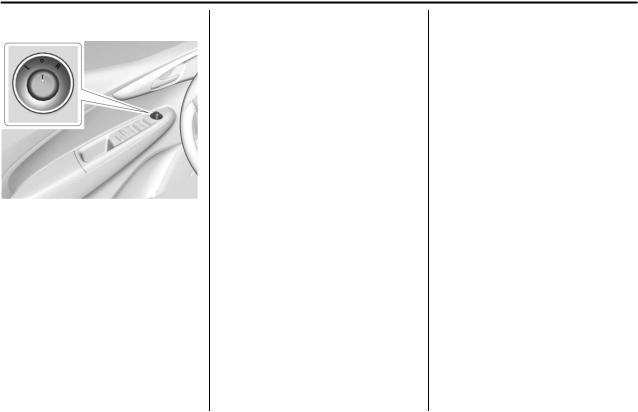
Keys, Doors, and Windows 25
Power Mirrors
1.If equipped, move the selector switch to L (Left) or R (Right) to choose the driver or passenger mirror.
2.Use the control knob to adjust the mirror so the side and the area behind the vehicle can be seen.
3.Return the selector switch to the center when done.
Folding Mirrors
Manual Folding Mirrors
The vehicle has manual folding mirrors. These mirrors can be folded inward to prevent damage when going through an automatic car wash. To fold, pull the mirror toward the vehicle. Push the mirror outward to return it to the original position.
Heated Mirrors
If equipped, the rear window defogger also heats the outside mirrors.
1 : Press to heat the outside mirrors.
See “Rear Window Defogger” under
Climate Control Systems 0 143.
Interior Mirrors
Interior Rearview Mirrors
Adjust the rearview mirror for a clear view of the area behind your vehicle.
If equipped with OnStar, the vehicle may have three control buttons at the bottom of the mirror. See OnStar Overview 0 305.
To avoid accidental OnStar calls, clean the mirror with the ignition off. Do not spray glass cleaner directly on the mirror. Use a soft towel dampened with water.
Manual Rearview Mirror
Push the tab forward for daytime use and pull it rearward for nighttime use to avoid glare of the headlamps from behind.
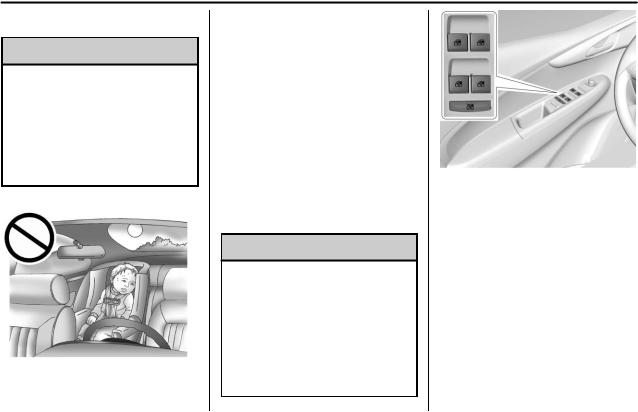
26 Keys, Doors, and Windows
Windows
{Warning
Never leave a child, a helpless adult, or a pet alone in a vehicle, especially with the windows closed in warm or hot weather. They can be overcome by the extreme heat and suffer permanent injuries or even death from heat stroke.
The vehicle aerodynamics are designed to improve fuel economy performance. This may result in a pulsing sound when either rear window is down and the front windows are up. To reduce the sound, open a front window.
Manual Windows
If equipped, turn the hand crank on each door to manually raise or lower the manual windows.
The rear windows do not open fully.
Power Windows
{Warning
Children could be seriously injured or killed if caught in the path of a closing window. Never leave keys in a vehicle with children. When there are children in the rear seat, use the window lockout button to prevent operation of the windows. See
Keys 0 7.
Power windows work when the ignition is on, in ACC/ACCESSORY, or when Retained Accessory Power (RAP) is active. See Retained Accessory Power (RAP) 0 167.
Using the window switch, press to open or pull to close the window.
The windows may be temporarily disabled if they are used repeatedly within a short time.
Window Lockout
This feature stops the rear door passenger window switches from working.

Keys, Doors, and Windows 27
.Press Z to engage the rear window lockout feature.
.Press Z again to disengage.
Window Express Movement
All windows can be opened without holding the window switch. Press the switch down fully and quickly release to express open the window.
If equipped, pull the window switch up fully and quickly release to express close the window.
Briefly press or pull the window switch in the same direction to stop that window’s express movement.
Window Automatic Reversal
System
The express-close feature will reverse window movement if it comes in contact with an object. Extreme cold or ice could cause the window to auto-reverse. The window will operate normally after the object or condition is removed.
Automatic Reversal System
Override
{Warning
If automatic reversal system override is active, the window will not reverse automatically. You or others could be injured and the window could be damaged. Before using automatic reversal system override, make sure that all people and obstructions are clear of the window path.
When the engine is on, override the automatic reversal system by pulling and holding the window switch if conditions prevent it from closing.
Programming the Power
Windows
Programming may be necessary if the vehicle battery has been disconnected or discharged. If the window is unable to express-up, program each express-close window:
1.Close all doors.
2.Turn the ignition on or to ACC/ ACCESSORY.
3.Partially open the window to be programmed. Then close it and continue to pull the switch briefly after the window has fully closed.
4.Open the window and continue to press the switch briefly after the window has fully opened.
Sun Visors
Pull the sun visor down to block out glare. Detach the sun visor from the center mount and swing it to
the side.
Visor Vanity Mirror
The vehicle may have vanity mirrors and card holders on the back of the sun visors. Swing down the sun visor to expose the vanity mirror.
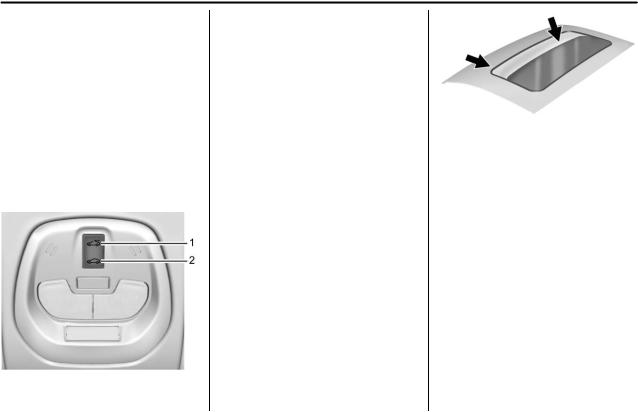
28 Keys, Doors, and Windows
Roof
Sunroof
If equipped, the ignition must be on or in ACC/ACCESSORY,
or Retained Accessory Power (RAP) must be active to operate the sunroof. See Ignition Positions (Keyless Access) 0 160 or
Ignition Positions (Key Access) 0 162 and
Retained Accessory Power (RAP) 0 167.
Express-Vent/Open : Press and release e(1) to express-vent. Press and release e(1) again to express-open the sunroof. Press the switch again to stop movement. The sunshade automatically opens with the sunroof, but must be closed manually.
Vent/Open : Press and hold e(1) to vent. Press and hold e(1) again to open the sunroof. Release the switch to stop movement. The sunshade automatically opens with the sunroof, but must be closed manually.
Close : Press and hold g(2) to close. Release the switch to stop movement.
The sunroof cannot be opened or closed if the vehicle has an electrical failure.
Dirt and debris may collect on the sunroof seal or in the track. This could cause an issue with sunroof operation or noise. It could also plug the water drainage system. Periodically open the sunroof and remove any obstacles or loose debris. Wipe the sunroof seal and roof sealing area using a clean cloth, mild soap, and water. Do not remove grease from the sunroof.

Seats and Restraints |
29 |
Seats and
Restraints
Head Restraints
Head Restraints . . . . . . . . . . . . . . . 30
Front Seats
Seat Adjustment . . . . . . . . . . . . . . . 31
Reclining Seatbacks . . . . . . . . . . . 32
Front Seat Armrest . . . . . . . . . . . . 33
Heated Front Seats . . . . . . . . . . . . 33
Rear Seats
Rear Seats . . . . . . . . . . . . . . . . . . . . 34
Seat Belts
Seat Belts . . . . . . . . . . . . . . . . . . . . . 36 How to Wear Seat Belts
Properly . . . . . . . . . . . . . . . . . . . . . . 37 Lap-Shoulder Belt . . . . . . . . . . . . . 39 Seat Belt Use During
Pregnancy . . . . . . . . . . . . . . . . . . . . 41 Seat Belt Extender . . . . . . . . . . . . . 42 Safety System Check . . . . . . . . . . 42 Seat Belt Care . . . . . . . . . . . . . . . . . 42 Replacing Seat Belt System
Parts after a Crash . . . . . . . . . . . 43
Airbag System
Airbag System . . . . . . . . . . . . . . . . . 43 Where Are the Airbags? . . . . . . . 45 When Should an Airbag
Inflate? . . . . . . . . . . . . . . . . . . . . . . . 46 What Makes an Airbag
Inflate? . . . . . . . . . . . . . . . . . . . . . . . 47 How Does an Airbag
Restrain? . . . . . . . . . . . . . . . . . . . . . 48 What Will You See after an
Airbag Inflates? . . . . . . . . . . . . . . 48 Passenger Sensing System . . . 49 Servicing the Airbag-Equipped
Vehicle . . . . . . . . . . . . . . . . . . . . . . . 54 Adding Equipment to the
Airbag-Equipped Vehicle . . . . . 54 Airbag System Check . . . . . . . . . . 55 Replacing Airbag System Parts
after a Crash . . . . . . . . . . . . . . . . . 55
Child Restraints
Older Children . . . . . . . . . . . . . . . . . 56 Infants and Young Children . . . . 57 Child Restraint Systems . . . . . . . 60 Where to Put the Restraint . . . . . 61 Lower Anchors and Tethers for
Children (LATCH System) . . . . 63 Replacing LATCH System Parts
After a Crash . . . . . . . . . . . . . . . . . 70
Securing Child Restraints (With
the Seat Belt in the
Rear Seat) . . . . . . . . . . . . . . . . . . . 71
Securing Child Restraints (With
the Seat Belt in the
Front Seat) . . . . . . . . . . . . . . . . . . . 73
